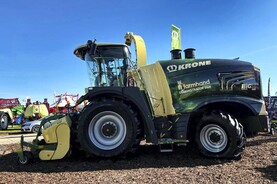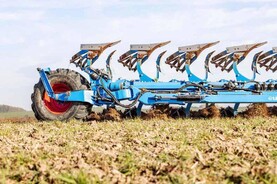Combined Powers is a joint project between Lemken and Krone and involves a diesel-electric autonomous tractor design concept.
First unveiled to the public two years ago, the project uses a diesel-electric drive that generates up to 230hp (170kW).
The manufacturers say the drive unit is designed to meet the power requirements of the implements used in processes such as cultivating, ploughing, sowing, mowing, tedding and raking.
Power is transferred electrically to the wheels and the PTO, and from there to the implement, which couples to a three-point linkage.
The drive unit boasts multiple sensor systems, which monitor the immediate surroundings and the implement attached, with safe operation and optimum results as the primary objectives.
The operators can control and monitor the combination from a mobile device, transmitting jobs and job reports via a communication module and the agrirouter, the established data exchange hub.
New updates for 2024
The two manufacturers have said they are now significantly expanding the range of applications for their autonomous process unit by utilising the front attachment space.
They say the functionality of the autonomous process unit has been enhanced by the integration of a front linkage and front PTO, allowing two separate, intelligent attachment spaces for both grassland and arable farming.
It now means Krone, for example, can use a front and rear mowing combination, while Lemken can utilise the additional function for stubble cultivation and sowing with a press or front tank.

For 2024, the autonomous process unit has been enhanced by the integration of a front linkage and front PTO.
The duo say the VTEs (autonomous process units) were further developed, taking into account ease of maintenance, practicality and optimisation of the sensor carriers.
It claims to also have improved the diesel-electric drive. The new generation of machines retains its power output of 230hp (170kW) and continues to feature four-wheel steering with large tyres.
The transport solution presented at Agritechnica 2023, using a drawbar, is possible in combination with front-mounted implements. The new tractor units are characterised by their uniform paintwork in dynamic platinum grey.
Tractor controlled by implement
The manufacturers say that the speciality of the process unit is that it is controlled by the implement and not vice versa.
The implement and the drive unit act as one integrated smart system. Based on the long experience of using IsoBus and tractor implement management on Krone and Lemken machines, the drive unit and implement communicate and interact, sharing all types of data.
The Combined Powers design concept was also developed to counter the increasing shortage of skilled labour in agriculture, while reducing the length of time farmers spend in the field.
The companies say that, instead, farmers will become system operators who merely monitor the process unit which delivers a consistent, accurate quality of work.
More efficiency
The two manufacturers say its Combined Powers project marks a decisive step towards efficiency and innovation in modern agriculture. Testing is set to continue to take place on various farms in Germany and neighbouring European countries to test the functionality and communication of the autonomous process units using various implements under real conditions.
In a joint statement, Krone and Lemken have said they are having dialogue with other implement manufacturers in order to exploit synergies and create added value for all customers.
They said both companies are endeavouring to further develop the product in close co-operation with practising farmers and to make it marketable as quickly as possible.
Combined Powers is a joint project between Lemken and Krone and involves a diesel-electric autonomous tractor design concept.
First unveiled to the public two years ago, the project uses a diesel-electric drive that generates up to 230hp (170kW).
The manufacturers say the drive unit is designed to meet the power requirements of the implements used in processes such as cultivating, ploughing, sowing, mowing, tedding and raking.
Power is transferred electrically to the wheels and the PTO, and from there to the implement, which couples to a three-point linkage.
The drive unit boasts multiple sensor systems, which monitor the immediate surroundings and the implement attached, with safe operation and optimum results as the primary objectives.
The operators can control and monitor the combination from a mobile device, transmitting jobs and job reports via a communication module and the agrirouter, the established data exchange hub.
New updates for 2024
The two manufacturers have said they are now significantly expanding the range of applications for their autonomous process unit by utilising the front attachment space.
They say the functionality of the autonomous process unit has been enhanced by the integration of a front linkage and front PTO, allowing two separate, intelligent attachment spaces for both grassland and arable farming.
It now means Krone, for example, can use a front and rear mowing combination, while Lemken can utilise the additional function for stubble cultivation and sowing with a press or front tank.

For 2024, the autonomous process unit has been enhanced by the integration of a front linkage and front PTO.
The duo say the VTEs (autonomous process units) were further developed, taking into account ease of maintenance, practicality and optimisation of the sensor carriers.
It claims to also have improved the diesel-electric drive. The new generation of machines retains its power output of 230hp (170kW) and continues to feature four-wheel steering with large tyres.
The transport solution presented at Agritechnica 2023, using a drawbar, is possible in combination with front-mounted implements. The new tractor units are characterised by their uniform paintwork in dynamic platinum grey.
Tractor controlled by implement
The manufacturers say that the speciality of the process unit is that it is controlled by the implement and not vice versa.
The implement and the drive unit act as one integrated smart system. Based on the long experience of using IsoBus and tractor implement management on Krone and Lemken machines, the drive unit and implement communicate and interact, sharing all types of data.
The Combined Powers design concept was also developed to counter the increasing shortage of skilled labour in agriculture, while reducing the length of time farmers spend in the field.
The companies say that, instead, farmers will become system operators who merely monitor the process unit which delivers a consistent, accurate quality of work.
More efficiency
The two manufacturers say its Combined Powers project marks a decisive step towards efficiency and innovation in modern agriculture. Testing is set to continue to take place on various farms in Germany and neighbouring European countries to test the functionality and communication of the autonomous process units using various implements under real conditions.
In a joint statement, Krone and Lemken have said they are having dialogue with other implement manufacturers in order to exploit synergies and create added value for all customers.
They said both companies are endeavouring to further develop the product in close co-operation with practising farmers and to make it marketable as quickly as possible.







 This is a subscriber-only article
This is a subscriber-only article










SHARING OPTIONS: